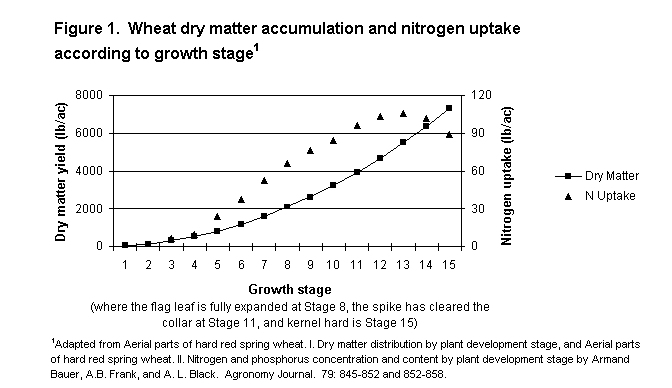| |
Nitrogen Management Strategies in Dry Conditions - Frequently Asked Questions | |
| |
|
|
| |
|
|
| | When it's dry, doesn't it make sense to only use minimal nitrogen (N) fertilizer with canola and cereals and then broadcast more N when moisture conditions improve?
Delaying N fertilization until after seeding will work in some situations, but the window of opportunity to make it successful is narrow and the decision about adding additional N must be made within a few weeks of seeding. Since top-dressed N is inefficient, and usually requires a custom floating operation, the total costs of broadcasting after seeding are considerably higher than if a comparable amount of N would have been applied at seeding.
When do crops need nitrogen?
Nitrogen is a significant component of proteins which are essential for growth. The N uptake pattern and dry matter accumulation of spring wheat by growth stage is depicted in Figure 1. At the 5-leaf stage, wheat starts to accumulate N rapidly while overall plant growth lags behind. Canola's N uptake pattern and peak demand period are similar to that of wheat. Canola must have assimilated a substantial portion of its total growing season N requirements prior to bolting. Nitrogen fertilizer must be in the root zone and available for uptake as crops enter their rapid growth period, perhaps within 4-5 weeks of seeding.

How effective is top-dressed nitrogen in meeting crop requirements?
At best, broadcast N after seeding will only be as efficient as broadcast and incorporated N, or about 20% less effective than N placed below the soil surface (Table 1). However, N immobilization and N volatilization ("gassing off") may prevent this best case scenario from happening.
Table 1. The relative effectiveness of methods and time of nitrogen application for increasing crop yield in dry soil conditions
| Spring broadcast and incorporated | 100 |
| Spring banded | 120 |
| Fall broadcast and incorporated | 90 |
| Fall banded | 120 |
Source: Fertilizer Application and Placement
Canola and cereal crop residues will immobilize N during the initial phases of decomposition. Nitrogen fertilizer applied into these residues will be tied up for weeks or possibly months. It is estimated that 20 to 30 pounds of N per acre will be immobilized for every ton of cereal crop residue from the previous year.
Broadcast urea (46-0-0) or UAN (urea ammonium nitrate, usually 28-0-0) can "gas off" and lose N back to the atmosphere. Fertilizer losses from these products depend on a combination of soil and environmental factors (Table 2). Nitrogen losses from broadcast urea or UAN applied when the soil is cold, such as in late April and early May, are minimal during the first 1-3 days. However, 25-50% N losses can occur in the first 7 days with the same products broadcast on warm soils.
Table 2. Soil and environmental factors that affect N losses from urea or UAN
Low Loss Potential | High Loss Potential |
Environmental Factors |
| Dry soil surface | Moist soil surface |
| Cold soils | Warm soils |
| No wind | Windy conditions |
| Greater than ½" rain within 1-3 days of fertilization | Less than ½" of rain or precipitation occurs more than 3-5 days after fertilization |
Soil Factors |
| Fine textured soils | Coarse textures soils |
| High soil organic matter content | Low soil organic matter content |
| Low lime content | High lime content |
| Few plant residues on soil surface | Abundant plant residues on soil |
How can I make topdressing work even though there are limitations with the practice?
- Decide ahead of time that more nitrogen will be applied if precipitation changes yield expectations. Perhaps set a target precipitation by a certain crop stage for decision-making purposes. Without predetermined conditions, too often post-seeding fertilization is never done even if there is rain.
- Fertilize as soon as possible after yield potential changes. The earlier the fertilizer reaches the rooting zone the greater the potential benefit to the crop.
- Evaluate gassing off loss potential and choose appropriate fertilizer. Keep in mind that rain is still needed after fertilization to move the nutrients into the root zone.
- Evaluate the potential for N immobilization. Increase N application rate if fertilizer is going into considerable crop residues
- Apply enough N to make a difference. Approximately 30% of broadcast N ends up in the crop under good conditions, and cereal and canola crops require about 2-3 pounds of N for every bushel of grain produced. Consider applying a minimum of 25-30 pounds of actual N per acre in addition to any estimated losses from gassing off or immobilization.
|
|
| |
|
|
| |
For more information about the content of this document, contact Mark Cutts.
This document is maintained by Brenda McLellan.
This information published to the web on March 26, 2004.
Last Reviewed/Revised on October 11, 2018.
|
|